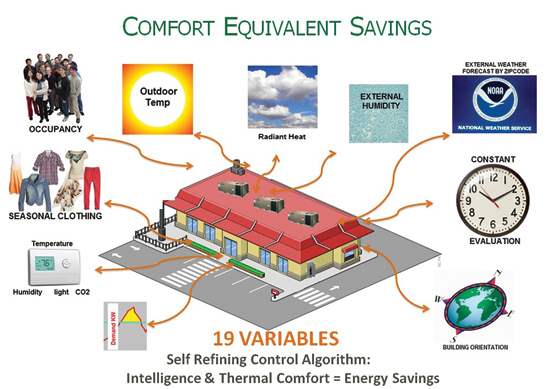It’s no secret that energy costs are on the rise, which inevitably translates to higher electric bills for businesses. With no end in sight, it’s hardly a surprise that energy efficiency programs are continually gaining more widespread attention and support from both businesses and utility providers. Many businesses hope these programs will help them gain better control of rising energy costs, while also addressing growing pressure to be more environmentally conscious. Utility companies are also not immune to the rising energy costs.
A New Way Forward
In an effort to reduce electricity usage and ensure that they can continue to provide service to a growing number of customers, utilities are providing incentives to businesses that implement energy efficiency programs. And while businesses are adopting simple practices – such as turning off lights, using less hot water and even keeping the thermostat at a less comfortable temperature – to reduce usage and be more environmentally-friendly, these measures often aren’t enough to provide any significant savings in energy costs.
New energy efficiency technologies on the market today provide a higher level of automation and intelligence than ever before, while also helping business owners reduce their electricity usage and costs. Additionally, there are many services available to help businesses navigate the often confusing landscape of utilities, energy supply and demand, and making smart decisions when it comes to energy usage. But can an energy efficiency program really save a business money? And what does a successful energy efficiency program mean for the utility companies?
For any business serious about implementing a successful energy efficiency program, identifying the right building optimization technology can be the first important step. Typically, HVAC systems account for a large portion – in many cases, more than 50 percent – of the total energy used by commercial buildings. HVAC units generally over-consume and under-perform due to a number of factors, including poor initial building design, lack of proper maintenance, poor control strategies and advanced equipment age, just to name a few. Heating and cooling a building is often controlled by setting fixed, pre-programmed temperature targets with simple “on/off” operations or by using a timer.
Overcompensation = Wasted Energy
Even in the best-maintained systems, business owners often compensate for HVAC systems by making heating and cooling times longer than necessary to ensure an “optimal” temperature is reached at the right time – typically during a building’s business hours. And, aside from temperature inside the building, other environmental influences are not normally taken into consideration with the controls for a HVAC system. For example, an overcast day will likely require less HVAC output than a sunny day. This leads to unnecessary over-usage of equipment, resulting in wasted energy – and higher electric bills.
Replacing older HVAC units with newer, more efficient ones can be expensive and is usually not even necessary to reduce energy costs. More and more businesses are looking for technology solutions that can help existing HVAC units to operate more efficiently, without sacrificing comfort inside the building. This can be especially challenging when considering all the factors that can influence the temperature in different areas of a building. Typically, most energy management systems only take into consideration the temperature in a single area inside a building, without taking into account the many variables that affect thermal comfort.
Intelligence + Thermal Comfort = Energy Savings
Like many other businesses, Platinum Corral – a multi-state franchise operator of Golden Corral Buffet-Grill restaurants – had implemented simple measures in an effort to reduce its utility bills, including scheduled and preventative maintenance on its HVAC compressors. Yet the company was not seeing a significant savings and typically paid around $9,000 per store every month for gas and electricity costs. To help reduce electricity usage and costs, Platinum Corral installed E2America’s intelligent building optimization technology in all 30 of its stores. Platinum Corral initially installed the technology in five of its Golden Corral restaurants, and immediately saw its electricity bills decrease by as much as $700 per store each month.

In order to ensure the maximum reduction in energy consumption, while still providing a comfortable climate,
building control systems must take a wide range of factors for controlling the HVAC system into account.
With restaurants located across five states, Platinum Corral worked with several of its local utility companies to qualify for a $5,000 - $8,000 rebate per store for installing energy efficiency technology. Most utility companies offer these incentives to help businesses implement programs and technologies that can help them reduce energy consumption and demand. These reductions can assist utility executives make more accurate predictions about their grids, including consumption and demand analyses, generation, transmission and rates.
When a business receives utility incentives to install energy efficiency technology, that business in return assigns “credits” or RECs (Renewable Energy Certificates) back to the utility, as a tradeable commodity. For every 10,000 kWh saved through energy efficiency technology, the utility company receives one REC. So while the utility company pays a one-time incentive to the business, the utility continues to receive RECs over time as the business reduces its consumption.
Energy efficiency technologies like E2America’s assist with transmission and distribution loading issues by lowering both consumption and demand on small to medium-sized commercial and retail buildings. Although these buildings use less energy than large commercial and industrial buildings, when enough buildings are added in a specific geographic area the aggregate savings have the potential to significantly lower the utilities demand.
Platinum Corral was able to install the retrofitted system directly to its existing HVAC units, which included various brands and ranged in age from one to 25 years. A new Master Control Unit with wireless controls for the system was installed in each store and connected to an Internet gateway. Instead of relying on set temperatures and time schedules to determine the energy used and HVAC costs, the new system uses a self-refining logic that calculates the optimum temperature every minute of the day.
Optimize, Prioritize, Save
This centralized control removes the incidental waste resulting from striving to achieve one set temperature. By allowing the Master Control Unit to intelligently calculate what the optimum temperature should be, the system uses the least amount of energy possible and improves the internal conditions of the building. Staff members no longer have to alter heating and cooling schedules or make random temperature adjustments, which had been contributing to excess electric consumption.
The system also uses an algorithm to lower demand charges by prioritizing units and ensuring that all units aren’t running at the same time. The technology automatically calculates intelligent start and stop sequences so the HVAC units only run for exactly the amount of time required to take the restaurant from its nighttime temperature to its target daytime temperature. This means no unnecessary usage of power before opening or after closing each day. The automated demand response functionality that is embedded in the self refining algorithm also enables the utility company to lower demand on participating buildings by an additional 10-15 percent at the touch of a button.
To further reduce energy consumption, the technology takes into account a wide range of factors instead of just target set temperature for controlling the HVAC system. Other factors considered include external weather data, internal and external humidity, solar heat load, building position and sunlight, typical clothing worn for the time of year, and building occupancy. Taking these factors into consideration allows the HVAC units to run more effectively without causing disruption, while also providing a more comfortable climate for staff and customers.
Wireless temperature and humidity sensors were also installed in various areas in each building to provide Platinum Corral with continuous reports of how the HVAC system is functioning and to provide daily and monthly snapshots of energy and cost reductions. As the company installs the technology in all of its locations, Platinum Corral expects to lower its electricity costs by as much as $252,000 annually. Additionally, the platform is scalable to add intelligence to each facet of energy consumption.
The Right Tool for the Job
Ultimately, the right energy efficiency technologies enable utility companies to do more with the energy they are currently generating by reducing waste. When enough commercial customers have installed these technologies, utilities can postpone or delay new generation budget decisions, translating to greater profitability. A megawatt saved is the same as a megawatt generated. Therefore, energy efficiency should be viewed as “low-hanging fruit” for both the utility companies and the businesses they serve. Saving now in order to avoid new energy generation projects in the future should be the goal for all utility companies and businesses in these challenging times.
Make A Plan
While identifying and implementing the right technologies can be a key component of a successful energy efficiency program, understanding how to make the most of fluctuating energy costs can also help a company save money when it comes to buying energy. Energy – whether electricity, natural gas or oil – is a commodity. And, like all commodities, prices change fast and frequently, varying by geographic region and even time of day. Cost is important but so is predictability. Having a strategic plan helps companies make informed decisions, taking all factors into consideration. The first step in formulating this plan is identifying a knowledgeable partner that can develop a comprehensive energy assessment.
Unlike other commodities, a facility’s location plays a major role in determining how it can buy energy. Typically, in a regulated market buyers must purchase energy from a single supplier, the local utility company. In a deregulated market, electricity suppliers compete for business. The regulation/deregulation of natural gas and electricity varies by geography. In some states both commodities are deregulated while in other states just one or the other is deregulated. These variations make a single approach to buying for multiple markets completely impractical.
Conclusions
Buying energy is extremely complex with many moving parts. Thoroughly understanding all the factors that can affect pricing – such as location, time of year, weather forecasts, regulatory and legislative initiatives – as well as how and when you use the energy, is absolutely critical. Once all these factors are considered and a strategic plan has been formulated, it is important to ensure that all suppliers are providing pricing on an “apples-to-apples” basis.
Variations in any one of these factors and how they are applied can have a significant impact on the actual price you ultimately pay. Once a supplier’s bid is chosen, negotiating the actual contract is the next critical step. Summit Energy will assist the customer in contract negotiation, ensuring there are no hidden costs or pass-through charges, while also keeping the client as flexible as possible within the terms of the contract.
Finally, keeping track of the energy reductions achieved is key to demonstrating success and charting performance towards goals. Working with a trusted partner that understands the numerous utility rebates and incentives, as well as the ever-changing legislation, can help companies even further supplement their reduction activities. And with proven, automated technology and services readily available, it is easier than ever for businesses to affordably implement a true energy management program that can result in reduced electricity usage and costs.
About the Authors

Dara O’Neill is CEO for Efficient Energy America (E2America). E2America develops building optimization and real-time reporting systems that are used by leading restaurant and retail chains, as well as other commercial buildings across the U.S.

Jim Vonderhaar is General Manager and Vice President of Regional Operations for Summit Energy Services. Summit leads companies to cost-effective strategies by providing energy procurement, sustainability consulting, energy procurement, rate analysis and demand response services.







